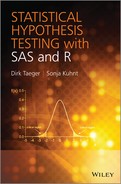Glossary
![]()
The significance level ![]() of a statistical test.
of a statistical test.
![]()
Distribution function of the standard normal distribution: ![]() .
.
![]()
The ![]() -quantile of the
-quantile of the ![]() -distribution with
-distribution with ![]() degrees of freedom (Table B.3 and Table B.4).
degrees of freedom (Table B.3 and Table B.4).
![]()
The ![]() -quantile of the t-distribution with
-quantile of the t-distribution with ![]() degrees of freedom (Table B.2).
degrees of freedom (Table B.2).
![]()
The ![]() -quantile of the standard normal distribution (Table B.1):
-quantile of the standard normal distribution (Table B.1): ![]() .
.
![]()
The absolute value of ![]() .
.
![]()
The sample mean of a sample ![]() :
: ![]() .
.
Continuity correction
A continuity correction is often applied when approximating the cumulative probability function ![]() of a discrete random variable by the standard normal distribution function. Usually a correction factor of
of a discrete random variable by the standard normal distribution function. Usually a correction factor of ![]() is used such that
is used such that ![]() .
.
Empirical distribution function (EDF)
Let ![]() be a descending ordered sample, then the EDF is defined as:
be a descending ordered sample, then the EDF is defined as:

![]()
Distribution function of the F-distribution with ![]() and
and ![]() degrees of freedom.
degrees of freedom.
![]()
The ![]() -quantile of the F-distribution with
-quantile of the F-distribution with ![]() and
and ![]() degrees of freedom (Tables B.5–B.7).
degrees of freedom (Tables B.5–B.7).
![]()
The null hypothesis of a test problem.
![]()
The alternative hypothesis of a test problem.
![]()
The sample size of a sample ![]() .
.
Ranks
Let ![]() be a sample. The ordered sample (from the lowest to the highest value) is
be a sample. The ordered sample (from the lowest to the highest value) is ![]() . Then
. Then ![]() of
of ![]() is the rank of the corresponding value
is the rank of the corresponding value ![]() . For example, let
. For example, let ![]() be a sample of size 5, then the ordered sample is:
be a sample of size 5, then the ordered sample is: ![]() . The rank of the sample value 2 is 1, the rank of sample value 3 is 2, and the rank of sample value 9 is 5.
. The rank of the sample value 2 is 1, the rank of sample value 3 is 2, and the rank of sample value 9 is 5.
Run
Let ![]() observations of random variable
observations of random variable ![]() and
and ![]() observations of random variable
observations of random variable ![]() be given. Assume that both samples are combined and (if at least ordinal) are arranged in increasing or time of occurrence order. A run is a group of successive observations generated from the same random variable. The same idea can be applied if the observations are coming from a binary random variable. For example, a coin is tossed 10 times; the result of these tosses are either (H)eads or (T)ails. The observed sequence is: HH T HH TTT H. This sequence has five runs, namely
be given. Assume that both samples are combined and (if at least ordinal) are arranged in increasing or time of occurrence order. A run is a group of successive observations generated from the same random variable. The same idea can be applied if the observations are coming from a binary random variable. For example, a coin is tossed 10 times; the result of these tosses are either (H)eads or (T)ails. The observed sequence is: HH T HH TTT H. This sequence has five runs, namely ![]() ,
, ![]() ,
, ![]() ,
, ![]() ,
, ![]() .
.
Mid ranks
This is a way of dealing with tied values, which are identical values in an ordered sequence. The same rank is assigned to these values, namely the mean of their ranks. For example, let ![]() be a sample. It is unclear if the observations 1, 3, or 4 will get the ranks 2, 3, or 4. The arithmetic mean of the ranks of the tied values is
be a sample. It is unclear if the observations 1, 3, or 4 will get the ranks 2, 3, or 4. The arithmetic mean of the ranks of the tied values is ![]() , so each value 4 will get the mid rank 3. The rank vector is
, so each value 4 will get the mid rank 3. The rank vector is ![]() while the sum of ranks is still 15.
while the sum of ranks is still 15.
p-value
The probability of observing a sample as discrepant with the null hypothesis ![]() as the observed sample under the null hypothesis.
as the observed sample under the null hypothesis.
Ties
If one or more observations in a sample have the same value they are called tied values.
![]()
Characteristic function: 
